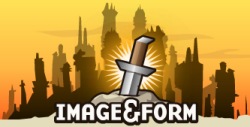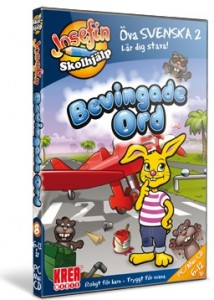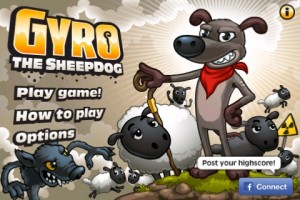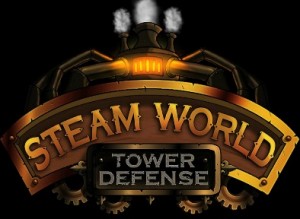 Image & Form is nearing 15 years of operation, is that correct? Has your company been developing videogames from the very beginning, or did its activities start in another area and branch out into videogames more recently?
Image & Form is nearing 15 years of operation, is that correct? Has your company been developing videogames from the very beginning, or did its activities start in another area and branch out into videogames more recently?
Image & Form started out in 1997, with multimedia presentations and graphic design as the core business. We then expanded into web design and programming, thinking that this would be our new core.
In 2001 we were asked to “save” a children’s game that had capsized. The game was one of the earlier titles in the popular Josefine franchise (now a market leader in the Nordic edutainment bracket), where the original developer went bankrupt. We programmed the last pieces of the game, developed in rustic Macromedia Director, and it went on to sell well. The publisher then asked us again in 2003 to develop a new Josefine game from scratch. We finished that game in 2004 and then another one in 2006. After that we picked up speed and made 20 Josefine titles in 30 months from 2007-2010, which means that computer games became our main line of business in 2007.
In 2010 we decided to move on to new genres and platforms, and created SteamWorld TD for the Nintendo DSi market (IGN’s Game of the Month, July 2010) and then Gyro the Sheepdog and Mariachi Hero for the iPhone/iPad. On October 6 we’ll release Anthill for the iPhone/iPad, and we are very excited. We think the game is a milestone in the history of strategy gaming.
 Would you say that the market facing Swedish videogame developers has undergone any major transitions or upheavals during your time in the industry?
Would you say that the market facing Swedish videogame developers has undergone any major transitions or upheavals during your time in the industry?
Yes, there have been major transitions. First and foremost, the PC market has stalled and even key industry people have been uncertain which direction the game industry is going in terms of platforms. Whereas mobile gaming is seen as growing exponentially, many developers have a hard time seeing how they will capitalize, since unit prices are very low and competition is fierce.
Looking at the Swedish game industry as a whole, the dark year was 2009, when the industry actually went into the red for the first time, and dipped quite low. The industry recovered well in 2010. We were fortunate to have our Josefine work-for-hire lineup, which meant that both 2008 and 2009 were excellent years for Image & Form – the best years to date. Interestingly, we went against the grain again and had a fiscally less than fantastic year in 2010. Mainly due to the fact that we switched platforms and genres. Lots to learn, and lots of early mistakes to make!
Looking over Image & Form’s videogame lineup, I had the sense that your company is in the midst of two interesting transitions or expansions: one in terms of the genres you’re focusing on, and the other in terms of the platforms you’re developing for.
First I want to ask about the shift from educational games to action and strategy titles – what led the company in this direction? Was this mostly a strategic move, or have your games on iOS and Nintendo DSi given the team artistic fulfillment in ways that are difficult to achieve in the edutainment genre?
The first question is very interesting. We had made so many educational games and other games for children, that we were dying to do something for a more mature audience. That said, I don’t think we’ll ever develop first-person shooters, since humor has always been important to us, and we won’t go into too much gore – we’re simply too childish.
The answer is mainly that we had done what we could with the Josefine lineup, and we were looking for other things to do. We weighed our options, and one of them was Real-Time Strategy. I was leaning more towards simple casual games at the time: all our educational titles had more of those elements, with a main screen and small tasks to be performed in casual-game settings, so we had the experience. However, we also felt that the casual scene was quickly becoming “set” or “established,” and that new casual games would have to be something out of the ordinary. After all, games like Flight Control, Doodle Jump, Angry Birds and Fruit Ninja were already there, and tons of games were coming every week. We simply didn’t have the killer casual game idea that would match those titles. Great casual games have come after that – one obvious example is of course Cut the Rope. One consideration is how many different casual games one customer will get, and I believe you’ll have to have a fantastic casual game idea to go ahead with it.
 That doesn’t mean that we didn’t give casual gaming a go. We developed Gyro the Sheepdog (self-published), which was a cool-looking game but with not enough gameplay, in my opinion. We decided to cut it short from the original multi-level idea to just a survival mode. It would take very much time to develop it all the way, and the release became a good learning case for us.
That doesn’t mean that we didn’t give casual gaming a go. We developed Gyro the Sheepdog (self-published), which was a cool-looking game but with not enough gameplay, in my opinion. We decided to cut it short from the original multi-level idea to just a survival mode. It would take very much time to develop it all the way, and the release became a good learning case for us.
We also developed Mariachi Hero, a work-for-hire game for Swedish publisher PAN Vision. The game is a dance/whack-a-mole hybrid (yes, I’d say there is such a thing!), and is actually very underrated. The game got an extremely bad initial review, where the reviewer hardly mentioned gameplay, but rather focused on the way we’d depicted two Mexicans in the game. They were cartoonish and stereotypical, but were perceived as racist statements. We were very surprised, since that never was our intention.
We had recruited very talented people who had time on their hands, and so we developed SteamWorld TD partly so that they would have something useful to do in the lull after Josefine, but also so that we could explore this new platform and see how good a strategy/TD game we could make. It went well, and so we decided to go on with Anthill. We knew what we had to do.
Artistic fulfillment also plays its part – it would have been hard to keep key members on the team if we were only churning out educational titles. We were working under harsh time constraints and often felt that we didn’t have time to really elaborate on gameplay, characters, settings, etc. Highly creative people always have great ideas, and they must come to fruition.
 And why the shift from development for PC and Mac to mobile? Do you view the transition to mobile as imperative for established developers if they’re going to survive in the long term?
And why the shift from development for PC and Mac to mobile? Do you view the transition to mobile as imperative for established developers if they’re going to survive in the long term?
For us it was vital – we had come to the end of the road of developing Josefine (at least from scratch), and had some hazy promises of localizations of those games, and we didn’t have any other openings for PC/Mac titles. I had taken every opportunity to “scratch the brains of the initiated,” and knew that PC/Mac sales would stall. It was a no-brainer anyway, store checks easily verified this. However, going to mobile wasn’t obvious to me – other platforms were enticing as well – but developing for the App Store was so very straightforward, that I felt that it would be the easiest way to go. Also, mobile was the only platform that would, for sure, grow exponentially.
No, I don’t think the switch is imperative. For example, many AAA developers will sell lots of PC games in the future, and there is still a market for children’s games, although the market is shrinking. But for smaller developers, mobile is a good way to go. However, I think it’s imperative that they come up with good ideas, develop great games and get help with the marketing side of things. If you have a good game, people will still have to find it.


